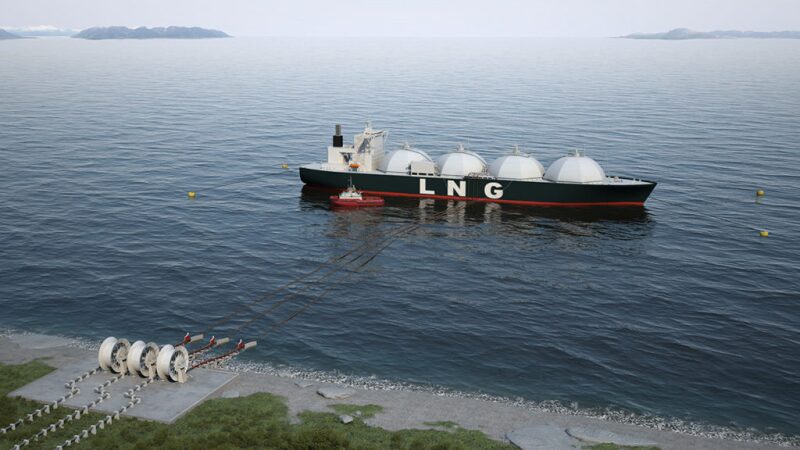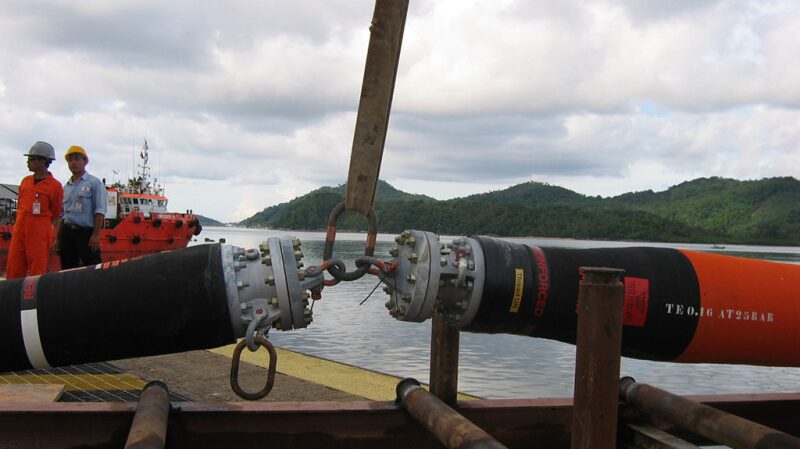According to a recent study, global trade for liquefied natural gas (LNG) is projected to rise by 50% by 2020, compared to volumes in 2014. Much of this demand comes from the fact that it is a flexible fuel, usable in multiple markets, regions, and configurations, and available widely. For us, as specialists in the process of oil and gas transfer from vessels, this reinforces the need to create transfer methods that are applicable no matter the environment, and that provide a level of flexibility that matches that of their cargo.
This rethink is underlined by changes that we are seeing in demand patterns for LNG, particularly gas power generation in the Asia-Pacific region. India is leading this charge, while China, Japan, and Korea are both gearing toward the fuel in a push to move away from high-polluting coal. In addition, remote regions in Indonesia and the Philippines are looking to LNG to fill the energy gap in places where access to the main grid is limited and power generation restricted. In line with these developments, there is a clear acceleration in demand for small- and medium- scale LNG, necessitating splitting of LNG into smaller load parcels.
This is reflected in the makeup of the global LNG fleet. While it continues to be dominated by large vessels, such as the recently launched Cesi Beihai, the 500th LNG carrier to join the fleet, it is gradually diversifying. Today, the live LNG fleet includes 26 floating storage regasification units (FSRUs) and 33 small-scale ships of 30,000 m³ or smaller, illustrating the need for LNG to reach a wider net of smaller terminals and power generation facilities, which are increasingly in remote areas. They are often serving as vital infrastructure for communities with restricted access to, or disconnected from, major power grids. The growing demand for LNG as a marine bunkering fuel is also contributing to this trend.
At the same time, 2017 is seeing floating liquefied natural gas (FLNG) projects come online. Shell’s Prelude FLNG facility recently arrived in Australian waters, while the world’s first converted FLNG vessel, the Hilli Episeyo, was named at the Keppel Shipyard. These projects similarly mark a departure for LNG extraction into deeper waters, where they must operate in harsh weather and rough seas.
These dynamics underscore a need for LNG transfer options to adapt accordingly. Traditional thinking in the transfer zone has been that, like coal and fuel oil, LNG vessels would moor dockside and transfer. They would use a jetty platform for ship-to-shore transfers, or use bridging arms for ship-to-ship transfers between an FSRU and a carrier, bunkering vessels, and LNG-powered ships, or between FLNG facilities and carriers. This thinking, however, is based upon fossil fuels. Gas, and its liquefied form, presents a different challenge in as much as it needs to be transported at a temperature of -163°C.
Any LNG transfer solutions require specialized hosing to transfer LNG to regasification plants onshore or, as increasingly envisaged, offshore. This has led to several breakthroughs for safe, efficient transfer – particularly to suit environments where the water may be too shallow for a ship to moor at a jetty, or where it may be too deep or too far offshore to build a jetty.
Cryogenic flexible floating hose technology, such as Trelleborg’s Cryoline hose, provides a unique solution to make LNG transfer safer, more efficient, and less Capex-intense in a variety of locations. The new floating cryogenic hose comprises several key components, including an inner cryogenic hose, an outer protective hose, an efficient insulation layer, and an integrated leak monitoring system. The inner cryogenic hose has been created from the latest developments in composite hose technology, which is already renowned for its unrivalled flexibility.
Composite LNG hoses typically consist of multiple unbonded, polymeric film and woven fabric layers, encapsulated between two stainless steel wire helices—one internal and one external. Essentially, the film layers provide a fluid-tight barrier to the conveyed product, with the mechanical strength of the hose coming from woven fabric layers. The number and arrangement of multiple polymeric film and woven fabric layers is specific to the hose size and application.
The polymeric film and fabric materials are selected to be compatible with the conveyed product and the operating temperatures likely to be encountered. Composite LNG hoses have already proven their suitability for the transfer of LNG. The technology has been validated through a series of full-scale static and dynamic tests, as well as with real-life testing in ship-to-ship LNG transfers. It has been demonstrated that insulated hoses can reduce boil-off by as much as 60%—equating to a saving of 10 billion Btu of energy over the course of 500 transfers. The outer protective hose draws on flexible rubber-bonded hose technology that is well-known for its high resistance to fatigue and ability to withstand harsh environmental conditions.
Composite LNG hoses can be used for floating or in submarine configurations, and conform with either OCIMF or API 17K specifications. Such technologies offer major technical and project execution advantages, making them attractive solutions, especially from the perspective of overall offloading terminal optimization.
FLNG/Ship-to-Ship
Offshore operations are among those that can benefit most from cryogenic hose technology, both floating FLNG and FSRUs.

Moving LNG production to an offshore setting presents a uniquely difficult set of challenges for the offshore oil and gas industry, particularly when it comes to the design and construction of FLNGs. Not only do FLNG facilities need to maintain the highest levels of safety, but extraction and transfer of the LNG to tankers needs to continue uninterrupted in even the most demanding conditions of climate and current, often hundreds of miles away from land.
The environmental conditions of many FLNG locations are at present relatively benign and so only require the use of the most straightforward technology for the unloading of LNG, usually in the form of cryogenic marine loading arms in side-by-side configuration. However, new FLNG locations are being established well away from these “mild” areas, to sites with substantial gas reserves but where sea conditions—such as those that will be faced by the FLNG Prelude—can be much more severe.
While loading arms are designed to handle both liquids and gases in a wide range of viscosities and temperatures, environmental constraints, such as tidal and wind conditions and the effect of earth movement, can have a significant effect on the performance of loading arms.
At the same time, the proximity of the FLNG and carrier necessary in this configuration—the distance between them can be as little at 5 m (16 ft)—has the potential to result in both operational issues and a higher risk of safety issues, with the worst case being a collision between the vessels. This is something which cannot be countenanced due to the remote nature of many FLNGs and the resulting lack in readily accessible proper repair equipment, components, and expertise—compounded by delays in transportation of the LNG and all the associated costs.
To address these issues, there has been a drive toward the employment of tandem offloading, with the two vessels situated one behind the other at approximately 100—150 m. This virtually eliminates the risk of collision and enhances the overall safety of the transfer process, allowing it to occur in even the most inhospitable conditions with waves of up to 10 m. This approach can also greatly simplify the processes of approach, berthing, and residence.
This approach is equally well suited to transfer between LNG carriers and FSRUs. Floating receiving and distribution terminals and coastal gas carriers are now an integral part of LNG activities and a crucial cog in the LNG supply chain. By using floating cryogenic hoses in tandem configuration, vessels can be moored as much as 300–500 m away from a storage unit. Again, this increased separation distance mitigates the risk of collision and ensures the safety of the vessels and crew and, moreover, the heavy-duty hose design reduces risk of damage to the hose during handling.
Ship-to-Shore
The flexibility and high flow rates achievable by cryogenic technology also makes it an ideal solution for ship-to-shore transfer. It increases the economic feasibility of power generation, terminal, and marine bunkering projects located away from existing infrastructure – particularly in areas where jetty-based transfer would be unfeasible thanks to harsh conditions or environmental concerns.
Trelleborg’s cryogenic hose-in-hose technology can negate the need for fixed onshore infrastructures; a concrete platform onshore combined with Cryoline hose transfer solutions offers an alternative that can be up to 80% more cost-effective for locations where fixed onshore infrastructure would be prohibitive.

Collaborations with partners such as Houlder, Wärtsilä, 7Seas, and ConnectLNG demonstrate how ship-to-shore operations using cryogenic floating hoses can be further enhanced, and offer increased flexibility and a choice of transfer options. Floating transfer terminals or barges can be connected to the shore using Cryoline hoses, which can then easily connect with a vessel using a transfer system on a barge. These solutions can be built, outfitted, and commissioned off-site in parallel with relatively light civil engineering activity, reducing the overall timescale from contract award to first gas.
As a self-contained mobile unit, a floating barge or transfer unit can be readily adapted for future and alternative deployment in the event of local changes or a desire to move location entirely, and individual components can be up- or downscaled depending on requirements. A floating solution also allows for refuge to be sought in a safe harbor during storms or hurricanes, deep maintenance to be undertaken at a shipyard, integration with a variety of LNG carrier mooring configurations, and the flexibility to support future, alternative applications. Moreover, the barge is also only used when transfer is underway, minimizing impact on the environment.
In conclusion, cryogenic hoses in floating configurations unlock new opportunities for LNG transfer both at sea and in near-shore environments, reducing risk of safety incidents and downtime, and lowering handling procedure time by as much as 60% in some instances. It is perhaps unsurprising then that the prognosis for this technology is good.
A study conducted by Mordor Intelligence, published August 2016, the Global Cryogenic Equipment Market—Growth, Trends and Forecasts (2016–2021), estimated that the global cryogenic equipment market was USD 15.3 billion in 2015 and projected it to reach USD 23.5 billion by 2021, a growth rate of 7.4% per annum during the forecast period. As the use of LNG continues to expand into new locations and in new practices, it is essential that the infrastructure accompanying it keeps pace in a manner that is sustainable and flexible. Cryogenic hose technology is a key element in making this a reality.

Vincent Lagarrigue, director at Trelleborg Oil and Marine, is an expert in crude oil offloading solutions and LNG offshore transfer and has worked at Trelleborg for more than 10 years. He handles Oil & Marine’s complete product range of oil and gas transfer systems, including solutions for floating LNG and small-scale LNG applications. At Trelleborg, Lagarrigue has been responsible for the design and qualification of flexible bonded hoses for offshore crude oil transfer (oil offloading lines, reel systems) and LNG transfer. He holds an MSc in mechanical engineering from the IFMA, and an executive MBA in finance and entrepreneurship from the EM Lyon Business School. For He may be contacted at oilandmarinehoses@trelleborg.com.

